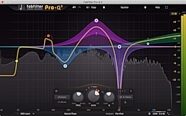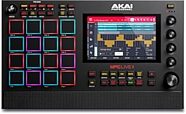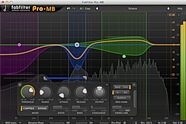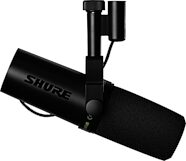Eventide Reverb 2016 Stereo Room Native Plug-In Software
No longer available at zZounds

Sound like you've got the classic Eventide SP2016 effects processor in your rack, with Eventide's Reverb 2016 Stereo Room Native plug-in software.
Overview
The Eventide Reverb 2016 recreates the legendary reverb algorithms of Eventide's SP2016 stereo room, room reverb and high-density plate. Every aspect of the original effects has been duplicated including every detail of the user parameters.
Some equipment racks are lucky enough to have an Eventide SP2016. It's an effects processor from the mid-1980s that included several reverb algorithms that are still prized today: Stereo Room, Room Reverb, and High Density Plate. Eventide has recreated these reverb sounds as a set of DSP-based plugins with the Reverb 2016.
Creating a reverb algorithm is part art and part science. The science bit is all about the naturalness of the sound -- whether the simulation convincingly conveys the "feel" of a real room.
Some digital reverbs don't have the horsepower to run a sufficiently complex program to achieve "naturalness." Without enough processing power the effect will suffer from low echo density or unnatural density growth with time or comb filter effects, etc. As Einstein is alleged to have said "things should be as simple as possible, but no simpler." This principle certainly applies to reverb algorithms.
The art of reverb algorithm design begins with simulating a 'room' that actually sounds good. Needless to say, rooms exist in the real world that sound awful. The structure of the reverb algorithm combined with the choices of delay lengths, interconnects, filter placement, early reflections, etc. all contribute to the overall sound. The… read more final element of the art of reverb design is the designer's choice of the ways in which, and the extent to which, the artist/engineer/producer is permitted to modify the effect. What are the parameters and what do they do?
The degrees of freedom available to the designer guaranty that no two (sufficiently complex) reverb algorithms will sound the same. Each will be unique. There are a number of popular digital reverberators for good reason. Each has a distinctive sound, each has a particular set of possibilities. The SP2016 reverbs have attracted a loyal user base because of a particular blend of art and science. They sound natural. They sound distinctive. And, although they allow the user to vary the effect dramatically, the controls can't be set in such a way as to create an unnatural sounding effect - this is a good thing.
The algorithms naturally simulate every aspect of the sound of a real enclosure - from the complex early reflections, to the natural way in which the echo density increases with time, to the smooth Gaussian decay of the reverb tail. A powerful simulation that lends itself to parametric control - a good thing indeed.
- Presets by John Agnello (The Hold Steady, Patti Smith, Dinosaur Jr.), Joe Chicarelli (U2, Elton John, White Stripes), Stewart Lerman (The Roches, Antony and the Johnsons, and Crash Test Dummies), and George Massenburg (James Taylor, Billy Joel, Dixie Chicks) have been added.
- Natural and distinctive; unique sound
- Simple, intuitive parametric controls
- Complex early reflections
- Smooth decay tail
- Novel Position control for precise room placement
- Decay control sets the reverb time
- Predelay adds a delay before the reverb
- Diffusion alters the character of the space
- EQ block: corner frequency and gain controls
- Input gain control for precise level matching
- Kill button for quick effect audition read less
Some equipment racks are lucky enough to have an Eventide SP2016. It's an effects processor from the mid-1980s that included several reverb algorithms that are still prized today: Stereo Room, Room Reverb, and High Density Plate. Eventide has recreated these reverb sounds as a set of DSP-based plugins with the Reverb 2016.
Creating a reverb algorithm is part art and part science. The science bit is all about the naturalness of the sound -- whether the simulation convincingly conveys the "feel" of a real room.
Some digital reverbs don't have the horsepower to run a sufficiently complex program to achieve "naturalness." Without enough processing power the effect will suffer from low echo density or unnatural density growth with time or comb filter effects, etc. As Einstein is alleged to have said "things should be as simple as possible, but no simpler." This principle certainly applies to reverb algorithms.
The art of reverb algorithm design begins with simulating a 'room' that actually sounds good. Needless to say, rooms exist in the real world that sound awful. The structure of the reverb algorithm combined with the choices of delay lengths, interconnects, filter placement, early reflections, etc. all contribute to the overall sound. The… read more final element of the art of reverb design is the designer's choice of the ways in which, and the extent to which, the artist/engineer/producer is permitted to modify the effect. What are the parameters and what do they do?
The degrees of freedom available to the designer guaranty that no two (sufficiently complex) reverb algorithms will sound the same. Each will be unique. There are a number of popular digital reverberators for good reason. Each has a distinctive sound, each has a particular set of possibilities. The SP2016 reverbs have attracted a loyal user base because of a particular blend of art and science. They sound natural. They sound distinctive. And, although they allow the user to vary the effect dramatically, the controls can't be set in such a way as to create an unnatural sounding effect - this is a good thing.
The algorithms naturally simulate every aspect of the sound of a real enclosure - from the complex early reflections, to the natural way in which the echo density increases with time, to the smooth Gaussian decay of the reverb tail. A powerful simulation that lends itself to parametric control - a good thing indeed.
Features:
- Three great plug-ins: Stereo Room, High Density Plate, and Room Reverb- Presets by John Agnello (The Hold Steady, Patti Smith, Dinosaur Jr.), Joe Chicarelli (U2, Elton John, White Stripes), Stewart Lerman (The Roches, Antony and the Johnsons, and Crash Test Dummies), and George Massenburg (James Taylor, Billy Joel, Dixie Chicks) have been added.
- Natural and distinctive; unique sound
- Simple, intuitive parametric controls
- Complex early reflections
- Smooth decay tail
- Novel Position control for precise room placement
- Decay control sets the reverb time
- Predelay adds a delay before the reverb
- Diffusion alters the character of the space
- EQ block: corner frequency and gain controls
- Input gain control for precise level matching
- Kill button for quick effect audition read less
Specs
Compatibility List:
- Intel Mac (ProTools 8.x)
- PPC Mac (ProTools 6.x & 7.x)
- Win XP (ProTools 6.x & 8.x)
- Intel Mac (ProTools 8.x)
- PPC Mac (ProTools 6.x & 7.x)
- Win XP (ProTools 6.x & 8.x)
No longer available at zZounds
In most cases, a product is unavailable because it has been discontinued by the manufacturer
This is a carousel with product cards. Use the previous and next buttons to navigate.











